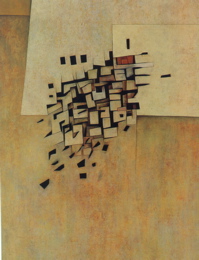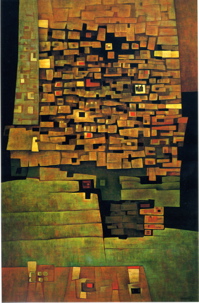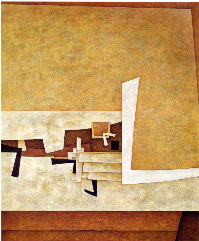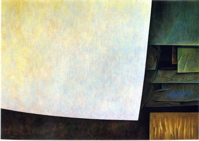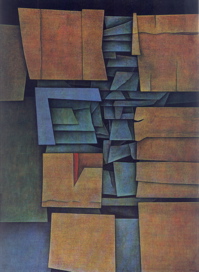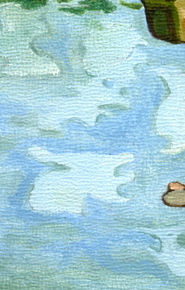- The Appeal of Günter Gerzo’s abstract paintings?
- Gerzo’s Mystery behind the Order
- An Experiential Resonance – An Idea expressed Visually
- Photorealism for those who believe in a mechanical Universe?
- Gerzo’s ambiguous abstractions disturbing for Scientific Rationalists?
- Did Social Revolution have anything to do with Art Revolution of the 20th?
- Did the Intellectual Revolution inspire Gerzo and his fans?
- Is Gerzo’ Art hard to grasp for those who prefer certainty?
- Do entire Cultures prefer the same kind of Art?
- Does Gerzo’s Art appeal to those who are comfortable with not knowing?
- My Painter’s Magical Animism reflected in embedded figures.
- If Philosophy and Art linked, then No Absolute Criteria for Beauty?
- Gerzo, Beauty, and understanding my Paintings
The Appeal of Günter Gerzo’s abstract paintings?
Gunter Gerzo was a famous Mexican abstract artist who lived during the same period as Orozco, Rivera, Ortega, and Tamayo - but was overshadowed by their political realism. Upon viewing his abstract paintings a question arose. Why were they so appealing to me? Many found them inaccessible and others boring – perhaps due their non-representational nature. One lady said, “What’s the point?” These reactions astonished me as the beauty of his art completely amazed me; and the content, albeit abstract, inspired me – even went to see the exhibit a second time. I began wondering what I saw that others didn’t – why I deemed it incredibly beautiful and others were confused or bored by it.
Gerzo’s Mystery behind the Order
What about Günter Gerzo’s paintings excited me? Broad swatches of magnificent color with mystery and ambiguity hidden behind. His is not the kind of abstract art with no relation to ordinary reality. Instead one gets a strong sense of front and back – of a clearly defined space. However at the edges and corners of these masterpieces are impossibilities – with interlocking pieces fitting together in Escher-esque fashion – i.e. they work locally but not globally. Viewed precisely from a holistic perspective it is impossible to form a coherent framework. However if the Viewer doesn’t look too closely the spaces seem entirely plausible. As with Da Vinci’s unreal landscapes in the background of his portraits – they seem to make sense on the surface but really don’t.
An Experiential Resonance – An Idea expressed Visually
“Ah!” I think to myself. “Words couldn’t have expressed it any better – this ambiguity I feel towards existence – its inherent paradoxical nature amidst the apparent order. Just don’t look too close.” Then an ‘Aha!’ moment. “Hmmm? Of course I enjoy the compositions for their color and lines. However what takes my breath away is that Gerzo's art perfectly reflects my philosophy of life. Hmmm? Perhaps one is drawn to Art that expresses one’s reaction to the Universe – one’s perception of reality – one’s implicit belief structure or philosophy.”
Photorealism for those who believe in a mechanical Universe?
Does this mean that photorealism appeals to those who believe in a mechanical world of cause/effect, which is ultimately understandable – with clearly defined good guys and bad guys – right and wrong firmly established – with up & down, 'is' & 'is not', accurately and distinctly delineated – where fractal boundaries don’t exist? Does it mean that abstraction is abhorrent to those with this either/or mentality – maybe haven’t looked closely enough – maybe vested interest clouds their sight – or perhaps they don’t know what they’re looking for and so can’t recognize a paradox when they see it – thinking somehow that these regular occurrences are just anomalies that will eventually be explained away – when in actuality the Mystery forms the Fabric of the Universe – where at the very end of Creation when everything was almost finished - they had to tuck the upper left corner into the bottom right so that it would all hold together – hoping that no one would notice the discrepancy? Does this philosophical stance have any effect whatsoever on art preferences? Probably not, but maybe so.
Gerzo’s ambiguous abstractions disturbing for Scientific Rationalists?
Would those who are comfortable living in their 3D world – where everything has its place – where good is rewarded and evil punished by an all just and all powerful supreme Deity – or where cause/effect science can explain everything – find the uncertainty of Günter Gerzo’s odd representations disturbing – maybe even stomach upsetting, if they looked too hard – a physical manifestation of cognitive dissonance – as this non-verbal sight challenges are the notion of a comprehensible world where everything has meaning – everything is resolved – where Western culture is the peak of social evolution – where all others bow down before our remarkable achievements.. It’s no wonder that representational art reigned supreme during the Age of Enlightenment – the heady days of unchallenged Reason – when the French Art Academy had clearly defined standards of excellence – based in part upon the artist’s ability to create a believable 3D space filled with recognizable objects. Abstract expressionism and even French impressionism didn’t pass their rigid standards – broke too many rules.
Did Social Revolution have anything to do with Art Revolution of the 20th?
Were the art movements that challenged these notions – Impressionism, Cubism and Abstraction – a reaction to the breakdown of the stratified social order that had generated so much certainty in the privileged classes – the patrons of the art? Was this bending of the rules of painting, which had glorified realism, instigated in part by the overthrow of the arrogant and aggressive ethnocentrism of England and Western Europe, which led to the multiple world wars and the resulting social turbulence of the 20th century? Did Einstein’s Theory of Relativity, which tumbled Newton’s 3D world of clearly differentiated space, time and energy, play a part in the Gerzo’s representations of a shattered space? Did the scientific discovery of multiple Ice Ages – which shattered the mindset that God had created the world in 7 days – thus challenging the notion that the Words of the Bible were absolute literal truth – undermine the authority of the French Art Academy as well? Did Darwin’s theory of evolution, which cast doubt on the entire Biblical mindset and accompanying social order that had held sway for a millennium and a half, play any part in the challenging of the rules and institutions that had determined ‘good’ and ‘bad’ art for so long? Did the American experiment in democracy – which eventually spread to include the entire Western World – and dismantled the idea that one class of people was inherently superior to another due to breeding – a better stock – have anything to do with the new subject matter – which included peasants and prostitutes rather than warriors and kings? Did the separation of church and state which established religious tolerance as a government policy backed up by Law – inexorably destroying the notion there was only one true way of reconstructing the Universe so that it makes some kind of vague sense – have anything to do with the demise of one-point perspective? Probably not to all these questions. But maybe so.
Did the Intellectual Revolution inspire Gerzo and his fans?
Did the scientific exploration into the anomalies at the edges of reality that revealed such spectacular truths inspire Gerzo’s paintings with their broad swatches of foreground color which obscure the intricate, hidden patterns of the background? Are those of us who have been immersed in this intellectual ferment attracted to Gerzo’s work because it expresses the uncertainty, the ambiguity, visually – no words or even recognizable objects? Do these abstract, yet paradoxical, representations nourish the psyches of quite a few of us – as evidenced by the fact that his work has achieved international acclaim – during his life and after his death – because they reflect our experience of reality? Who knows?
Is Gerzo’ Art hard to grasp for those who prefer certainty?
Do those who have continually filtered out paradoxical anomalies - who still live in the clearly defined colonial world of right and wrong – up and down – good guys and bad – tend to prefer representational art – because there is something recognizable – something they can clearly relate to – with standards that are easily perceived?
“Does it look like …? How close does it look like …? But Gerzo’s weird paintings don’t look like anything I’ve ever seen before. What is my reference frame? His art with those odd swatches of granulated hues with odd intersecting lines just don’t make any sense. Nothing to recognize – to hold up for comparison. What’s the point, if it doesn’t look like …? Anyone can put abstract scribbles on a page – even my 2-year-old niece.”
Do entire Cultures prefer the same kind of Art?
While these casual correspondences seem to make some kind of sense, they wouldn’t hold up in a court of law. As my Soul mate Laurie said, “I am concrete and I like abstract art”– presumably disconfirming the theory that the Viewer’s perception of Beauty is partially based upon his or her perception of Reality. However entire cultures of Viewers – those with a similar take on reality – seem to prefer similar art. For instance the Mongols paid outrageous prices for portraits of their horses in the 13th century – while the absolutists of the 19th century collected realistic representations (the more accurate the better) – and the relativists of the 20th century cultivated artists who stretched the limits of ‘looks like …’ or obliterated these boundaries altogether when it became abstract. Why do entire Cultures prefer the same kind of Art?
Does Gerzo’s Art appeal to those who are comfortable with not knowing?
Is it because each piece of Art expresses a cultural philosophy – whether it be love of horses, certainty, or paradox? Does this mean that no matter how neutral an art piece is it inadvertently expresses a philosophy, even if only on subliminal levels? And is it true that when this philosophy resonates with our own that we relish in the art – calling it Beautiful? Do those whose world is clearly defined prefer art based in realism, while those whose world is filled with paradox prefer art that includes ambiguity[1]. Does my Person find Günter Gerzo’s abstract paintings – with their broad bands of order laid over a mysterious background – so attractive because they reflect my preference for Order laced with Paradox? Does my Person find photo-realism unappealing – because he lives in a magical world filled with paradox and surprise – because his world can't be contained in a neatly wrapped box – too many inconsistencies at the edges? Are Gerzo’s ambiguous representations of reality appealing to him because he just doesn’t know – his mental constructs overturned too often to embrace certainty.
My Painter’s Magical Animism reflected in hidden figures.
If Art reflects our Perception of Reality then how do my Person’s paintings reflect his magical and animistic worldview? Multiple hidden images and embedded faces peeking out from amidst ripples, rocks, clouds, and bushes, with some mysterious objects in the background – reflecting the notion the entire Universe is alive with intentionality. No dry, raw Realism here.
If Philosophy and Art linked, then No Absolute Criteria for Beauty?
If the Art we are attracted to or create either reflects or balances our Reality, there are no absolute criteria for Beauty. If the Perception of Beauty has this personal philosophical component then Beauty herself is relative – subject to the internals of the Perceiver, rather than determined by external criteria. If this theory is true the reference frame of the Observer determines Beauty rather than some kind absolute yardstick based upon a divine form, which exists somewhere in the ozone. Einstein’s theory of relativity applied to Beauty.
Gerzo, Beauty, and understanding my Person’s Paintings
Perhaps this essay is meant to answer the question of the appeal of Günter Gerzo’s abstract paintings. Perhaps it is meant to explore the nature of Beauty – which seems to be so personal and subjective, rather than general and objective. Or perhaps this is an oblique verbal justification of my own unusual paintings – a definite blend of abstract and realism – certainly not for everyone – certainly not for those who live in a mechanical world – certainly not for those who prefer ‘looks like …’ to ‘paradox and mystery’.
